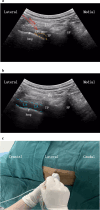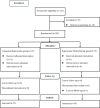Liposomal Bupivacaine in Ultrasound-Guided Paravertebral Block Reduces Opioid Consumption and Accelerates Recovery After Thoracic Surgery: A Randomized Controlled Trial
- PMID: 41080070
- PMCID: PMC12514961
- DOI: 10.2147/DDDT.S550595
Liposomal Bupivacaine in Ultrasound-Guided Paravertebral Block Reduces Opioid Consumption and Accelerates Recovery After Thoracic Surgery: A Randomized Controlled Trial
Abstract
Background: Liposomal bupivacaine (LB) can provide prolonged analgesia, which may reduce patients' opioid consumption, improve comfort, and facilitate recovery. Looser tissue and lower vascularity in the paravertebral space may facilitate LB diffusion and duration, so we investigated the effects of LB in multimodal analgesia after thoracic surgery with paravertebral block.
Methods: In this single-center, double-blind, randomized, parallel-controlled trial, 102 patients undergoing elective thoracoscopic surgery were randomized 1:1 to thoracic paravertebral block with LB (6.67 mg/mL) or ropivacaine hydrochloride (RH; 0.33%). The primary outcome was opioid consumption within 72 h postoperatively. Secondary outcomes included pain ratings at 6, 12, 24, 48, and 72 h postoperatively; rescue analgesia; time to first ambulation and defecation; post-anesthesia care unit and hospital length of stay; and adverse events.
Results: One patient was excluded due to block failure, leaving 101 patients (LB group, n = 51; RH group, n = 50). LB significantly reduced 72-h opioid consumption compared to RH (difference = -181.4 mg; 95% CI: -232.8, -130.0 mg; P < 0.001), and fewer patients in the LB group required rescue analgesia compared to the RH group (OR: 0.33; 95% CI: 0.13, 0.82; P < 0.05). Pain scores at 24 h were lower in the LB group than RH group (difference = -0.44; 95% CI: -0.84, -0.04; P < 0.05), with no differences at other timepoints. The LB group had shorter time to first ambulation than the RH group [median time (IQR): 20 (18-24) h vs 26 (22-32) h; HR: 3.81; 95% CI: 2.32, 6.19; P < 0.001] and shorter time to defecation [median time (IQR): 56 (42-65) h vs 72 (57-80) h; HR: 3.98; 95% CI: 2.46, 6.44; P < 0.001].
Conclusion: Ultrasound-guided paravertebral block with LB may reduce postoperative opioid consumption and enhance recovery in patients undergoing thoracic surgery.
Trial registration: Chinese Clinical Trials Registry Platform (chictr.org.cn): ChiCTR2400091217.
Keywords: liposomal bupivacaine; multimodal analgesia; pain management; thoracic paravertebral block; video-assisted thoracoscopic surgery.
© 2025 Wang et al.
Conflict of interest statement
The authors declare no conflicts of interest and confirm that the study was conducted without any commercial or financial relationships.
Figures





References
Publication types
MeSH terms
Substances
LinkOut - more resources
Full Text Sources

